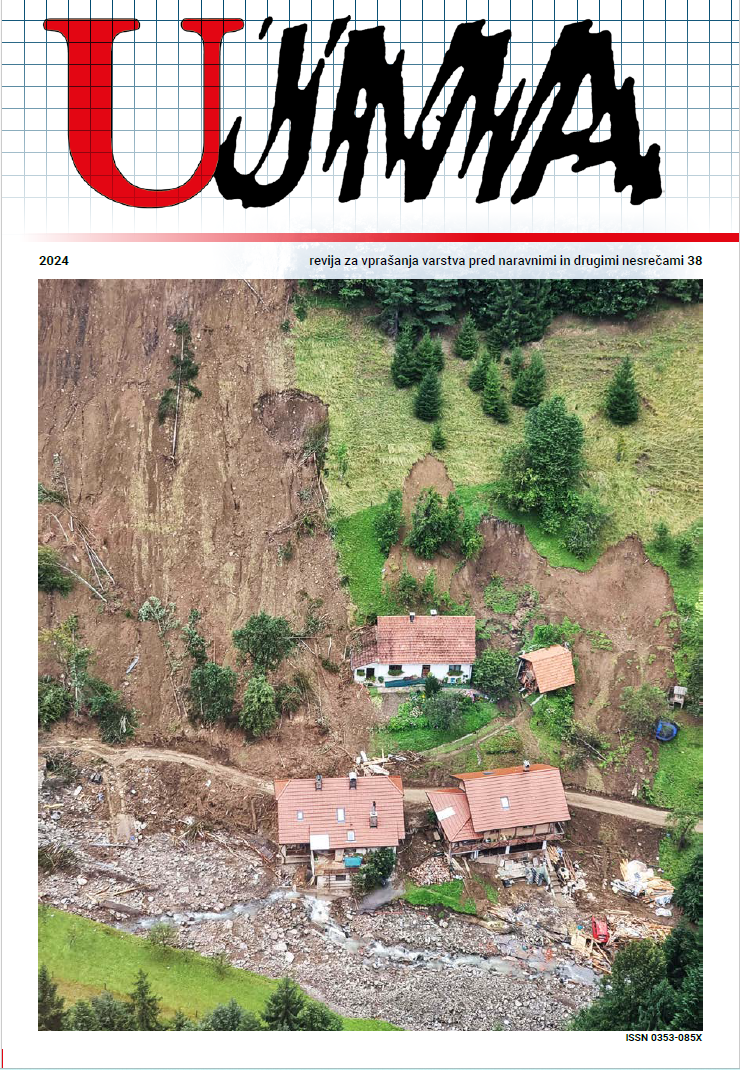SEISMIC DETECTION OF EXTREME WEATHER EVENTS IN 2023 ON THE SLOVENIAN NATIONAL SEISMIC NETWORK
Abstract
Seismic stations are not only suitable for detecting earthquakes, but can also detect other natural phenomena. When these phenomena leave their „seismic footprint“ on the records of ground motion, this enables us to analyse the phenomenon seismically and, consequently, to reveal its dynamics. This also applies to the extraordinary weather events we recorded in Slovenia in 2023. We investigated what kind of seismic imprint various extreme weather events leave on the seismic records of the Slovenian National Seismic Network. Rain is not detected; although rain does leave a seismic imprint, it is located at higher frequencies than are covered by the measurement range of the seismometer. Strong ground wind in the immediate vicinity of the seismometer significantly contributes to an increase in seismic noise both in the low-frequency part of the spectrum, where it is detected mainly on the horizontal components of the seismometer, and also in the high-frequency part of the spectrum, where the impact is recorded spatially. Rivers also leave a seismic footprint, which is recorded if river flows are significantly increased and if the seismic observatory is close enough to the river.
References
ARSO, 2024a. Atlas Okolja. https://gis.arso.gov.si/atlasokolja/profile.aspx?id=Atlas_Okolja_AXL@Arso, 14. 6. 2024.
ARSO, 2024b.Hidrološki podatki https://www.arso.gov.si/vode/podatki/, 14. 6. 2024.
ARSO, 2024c. Arhiv poročil o izrednih dogodkih do leta 2023, https://meteo.arso.gov.si/met/sl/climate/natural-hazards/archive/, 14. 6. 2024.
ARSO, 2024d. ARHIV – opazovani in merjeni meteorološki podatki po Sloveniji. https://meteo.arso.gov.si/met/sl/archive/, 14. 6. 2024.
ARSO, 2023a. Sneženje in močan veter med 21. in 24. januarjem 2023. https://meteo.arso.gov.si/uploads/probase/www/climate/text/sl/weather_events/sneg_veter_21-24jan2023.pdf, 14. 5. 2024.
ARSO, 2023b. Močan veter 4. februarja 2023. https://meteo.arso.gov.si/uploads/probase/www/climate/text/sl/weather_events/veter_4feb2023.pdf, 14. 5. 2024.
ARSO, 2023c. Neurja 30. julija in 1. avgusta. https://meteo.arso.gov.si/uploads/probase/www/climate/text/sl/weather_events/neurja_30jul-in-1avg2023.pdf.
ARSO, 2023d. Visoke vode in poplave med 14. in 19. majem 2023. https://www.arso.gov.si/vode/poro%c4%8dila%20in%20publikacije/Porocilo_visoke_vode_in_poplave_maj2023.pdf, 14. 5. 2024.
ARSO, 2023e. Hudourniška poplava reke Cerknice 13. julija 2023. https://www.arso.gov.si/vode/poro%c4%8dila%20in%20publikacije/Hudourni%c5%a1ka_poplava_reke_Cerknice_13.%20julija_2023.pdf, 14. 5. 2024.
ARSO, 2023f. Visoke vode in poplave med 20. in 26. julijem 2023. https://www.arso.gov.si/vode/poro%c4%8dila%20in%20publikacije/Visoke_vode_in_poplave_julij3dekada_2023.pdf, 14. 5. 2024.
ARSO, 2023dg. Izjemne poplave v Sloveniji med 4. in 8. avgustom 2023. https://www.arso.gov.si/vode/poro%c4%8dila%20in%20publikacije/Porocilo_visoke_vode_in_poplave_avg2023.pdf.
ARSO, 2023h. Poplave v Sloveniji med 24. oktobrom in 6. novembrom 2023. https://www.arso.gov.si/vode/poro%c4%8dila%20in%20publikacije/Poplave_Slovenija_okt-nov_2023.pdf. ARSO, 2023i. Visoke vode in poplave med 1. in 3. decembrom 2023. https://www.arso.gov.si/vode/poro%c4%8dila%20in%20publikacije/Visoke_vode_poplave_1-3_dec_2023.pdf.
ARSO, 2023j. Visoke vode in poplave 13. in 14. decembra 2023. https://www.arso.gov.si/vode/poro%c4%8dila%20in%20publikacije/Porocilo_visoke_vode_in_poplave_13-14dec2023.pdf.
Petan, S., 2024. ARSO – osebna komunikacija. Dr. Sašo Petan, 2024.
Tasič, I., 2015. Spodnja raven seizmičnega šuma v Sloveniji. Ujma, 29, 343–349.
Tasič, I., 2018. Seizmometer in pospeškometer – merilni par na potresni opazovalnici. Ujma, 32, 210–217.
Tasič, I., 2022. Ali je ustavitev javnega življenja v Sloveniji zaradi covida-19 znižala raven seizmičnega šuma. Ujma, 36, 241–246.
Diaz, J., Ruiz, M., Udina, M., Polls, F., Martí, D., Bech, J., 2023. Monitoring storm evolution using a high-density seismic network. Sci Rep 13, 1853 (2023). https://doi.org/10.1038/s41598-023-28902-8.
Dietze, M., Hoffmann, T., Bell, R., Schrott, L., Hovius, N., 2022. A seismic approach to flood detection and characterization in upland catchments. Geophysical Research Letters, 49, e2022GL100170. https://doi.org/10.1029/2022GL100170.
Knapič, M., Ulaga F., Preglau, A., 2019. Upravljanje s sedimenti v akumulacijskih bazenih hidroelektrarn na reki Dravi: predstavitev pilotnega projekta plavljenja sedimentov v matico reke Drave pri HE Vuhred. Zbornik, 30. Mišičev vodarski dan. 2019. https://mvd20.com/LETO2019/R25.pdf, april 2024.
Schmandt, B., Gaeuman, D., Stewart, R., Hansen, S. M., Tsai, V. C., Smith, J., 2017. Seismic array constraints on reach-scale bedload transport. Geology 2017; 45 (4): 299–302. doi: https://doi.org/10.1130/G38639.1.
Vidrih, R., Sinčič, P., Tasič, I., Gosar, A., Godec, M., Živčić, M., 2006. Državna mreža potresnih opazovalnic, ur. Vidrih, R., Agencija RS za okolje, Ljubljana.
Longuet-Higgins, M. S., 1950. A Theory on the origin of microseisms. Philos. Trans. R. Soc. Lond. A. 243, 1–35.
Downloads
Published
Issue
Section
License
Copyright (c) 2025 Ujma

This work is licensed under a Creative Commons Attribution-NonCommercial-NoDerivatives 4.0 International License.
The articles are made available to the public under Creative Commons Attribution-NonCommercial-NoDerivatives 4.0 International (CC BY-NC-ND 4.0).


